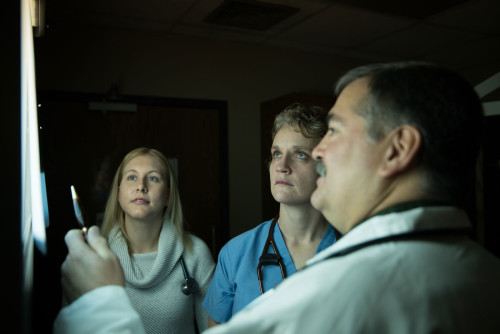
Entira Family Clinics Finds Prescription for Success with Innovative Staffing Model

An Entira care team at the Como/Roseville clinic examine a patient’s x-ray together (From left: Dr. John Nichols, Dr. Sara Whitehouse and Kelly Linnihan, certified physician’s assistant).
But the staffing model at Entira, part of a group of 12 independent primary care clinics in the St. Paul metro area, embraces a new model for care – one that uses a team of medical professionals to care for all of the patient’s health care needs.
Entira’s Approach
It’s this innovative staffing model restructure and a team-centered approach that will help Entira to reach its goal of being able to see more patients. The initiative actually started with something that sounds somewhat counterintuitive – lowering the number of doctors from six to four.
“In a six-doctor clinic, let’s say the average MD can see 20 patients per day, so on any given day, that’s 120 patients, and each has a clinical associate working with them to help with the exam, so they see the same 120,” Paul Berrisford, chief operating officer for Entira, said. “If we have 130 patients, then 10 are out of luck.”
In order to treat more patients in a given day, Entira is changing its model to run the clinic with fewer medical doctors – a number that fluctuates based upon the patient population of a given clinic.

Paul Berrisford is the chief operating officer for Entira Family Clinics.
Additionally, the clinic would hire more physician assistants, nurse practitioners, registered nurses and other health professionals, all of whom are paid less than doctors, but are qualified to treat patients with acute, everyday illnesses and injuries or provide protocol driven or supervised care. The Care Model will also add care managers to work with patients with illnesses like heart disease and diabetes to ensure they take their medications, monitor symptoms and maintain communication.
Under the new care design, the goal would be for the medical doctors to generally work at the top of their licenses and only see around 12-14 patients per day – typically unstable or chronically ill patients – while nurse practitioners and physician’s assistants are able to treat around 20 acute or stable chronically ill patients. Registered nurses would be able to address up to 35 protocol-driven touches, and care managers should be able to communicate with up to 35 to 50 patients, particularly because they can use phone or video conferencing for many of the appointments.
New Formula = Patient Centered
This new formula increases access to health care dramatically while keeping costs of care in check.
Meanwhile, Entira has faced a barrier to full implementation of this new care model: payment that was not without a solution. While Entira’s team-based approach aims to be more cost-effective for health care payers, the fee-for-service model (where a clinic’s payment is received based solely on the quantity of service delivered) will decrease in the volume of visits and likely mean less income for the clinic itself. It is here that Blue Cross stepped in with support as a strategic partner to Entira.
“Primary care across the country has a hard time surviving anymore because we have not built that up, and so much of the dollars in health care go to specialists, but it’s independent primary care that is important to us and it’s important to our consumers that we invest in it,” said Shannon Nelson, senior director of collaborative care and clinical innovation for health collaboration at Blue Cross.
“This new formula increases access to health care dramatically while keeping costs of care in check.”
“Blue Cross’ investment in Entira is not only to support innovative patient-centered care that reduces costs. It is an investment in independent primary care in general,” Nelson said.
“Across the state of Minnesota there are only a handful of independent primary care clinics left. Blue Cross has stepped up and done a marvelous job of supporting innovation and competition by giving us resources to work through this model, [and] help us with ideas and concepts,” Berrisford said. “They made an initial investment to give the resources necessary to help our planning process. They stepped up on the revenue side to help achieve this model. As we are currently implementing this, we are waiting to see the results.”
Entira’s Commitment to Its Community
Through local and strategic partnerships, Entira’s new model has added behavioral health professionals and social workers, who can work as part of a patient-centered team. “We add staff to do things that we can’t bill for, but it’s staff that we truly need because there are social determinants of health that need to be addressed,” he said. “It’s especially important in inner-city clinics where there are cultural and language barriers with immigrants.”
Putting the New Structure to Work
Additionally, Entira is working with Blue Cross to develop new structures that would allow for care managers to do advance monitoring of patients, including preventative care with heart patients and prescribing medication before problems worsen. Patients are beginning to become equipped with technology – monitors and self-reporting apps – that can be monitored remotely.
Previously, Entira charged patients $60 per month for care management, but many patients balked at the cost, despite the fact that the service was unlimited. As of January 2016, Blue Cross is in the process of addressing the monthly fee for their patients. In the long run, the Entira leadership team expects that it will also provide cost savings and higher-quality care.
See how Entira Family Clinics is helping generations thrive at entirafamilyclinics.com.
